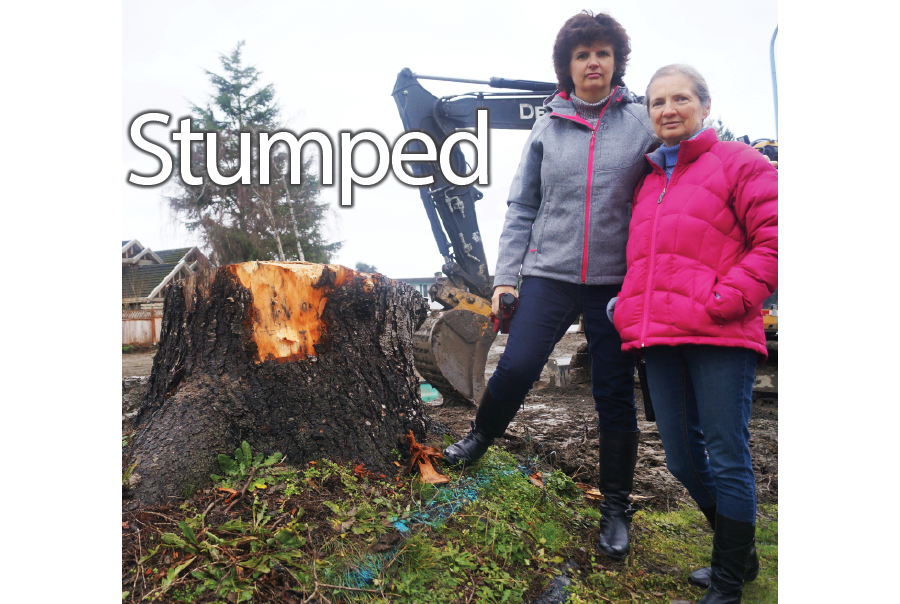Thompson resident Joe Wideski knows a thing or two about caring for a tree. Since 1974 he’s watched his backyard cherry tree grow into the centerpiece of his large backyard. Over time it’s gotten so big he’s had to prune large branches that hang over his home and, to add some colour in the winter months, he hangs boat buoys he’s collected from fishermen in Steveston.
“It’s the only tree in the world that gets exercise when the winds come,” quipped the 87 year-old.
It’s trees such as Wideski’s that Richmondite Cindy Lee is hoping to save from a growing wave of development across the city.
Although Richmond has a tree protection bylaw, the footprint of new homes trumps any protective measures for a mature tree. As a result, the city’s neighbourhoods are losing hundreds of mature trees each year.
And although the city has policies governing replacement trees, the size of new developments often make it impossible to plant a new tree on site.
In turn, Richmond’s existing urban forest canopy is not only diminishing but it’s shifting from neighbourhoods to parks or other public spaces.
City officials are, however, taking measures to work around the bylaw to save mature trees, and as new knowledge emerges about tree preservation methods and citizens become educated about the value of trees, they hope Richmond could end up with a healthier tree canopy in the decades to come.
The problem for Lee and others, however, is that existing residents will have to endure more chainsaws in the years to come, and there are no guarantees things will improve, unless more protective measures are taken.
In a chestnut shell, Lee contends Richmond’s bylaw is ineffective at protecting trees.
“I understand not all trees can be saved but I’m seeing a lot of trees close to city property and toward the back of properties that are being cut down. We’re replacing trees with gates and fences,” said Lee, who is documenting tree cutting on a Facebook page, Save Richmond Trees.
Why are trees important to Lee?
“We want to keep them for street appeal, to lower pollution and for bird habitat. Many of my neighbours agree. Loss of privacy is also an issue,” said Lee, joined by friend and fellow activist Sharon MacGougan at a razed rezoned site, with the Richmond News.
“There is a public responsibility to support the natural world,” said MacGougan.
While Lee and MacGougan’s valuation of trees may be subjective, TD Bank contends one should consider the more objective economic benefits of urban trees.
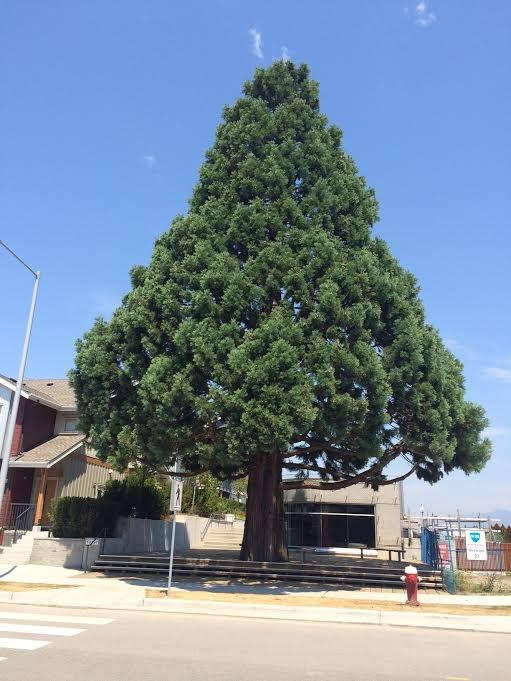
Trees save money
According to a September 2014 TD Economics report, for every dollar spent on urban forestry maintenance, between $1.88 and $12.70 in benefits are realized, depending on the city.
It would reason, according to the study’s co-author, Brian DePratto, that many of the benefits of urban trees cited by the study are of greater importance to Richmond, a city that may soon find itself permanently under sea level due to global warming.
The study noted trees capture and store pollutants and carbon, mitigating harmful climate effects. They also provide flood protection by absorbing precipitation.
Trees also shade and cool homes in the summer and block chilling winds in the winter, saving energy, and in turn reducing community carbon emissions.
Trees also filter pollutants out of storm water, which finds its way to ditches or the Fraser River and is subsequently used by local farmers.
By citing the few municipalities in the Lower Mainland that had studied their tree canopy (namely Vancouver and Surrey) TD estimated for each dollar the region spent on urban forestry residents received $4.59 in value.
“My intuition would be that the benefits are likely higher for (Richmond),” he said.
Bylaw worries
Tree Preservation Coordinator Gordon Jaggs is the man behind the city’s efforts to protect trees. At Richmond City Hall, he leads a crack team of three tree preservation officers, including him (Jaggs does not deal with street trees or parks).
A horticulturalist, Jaggs, like Lee, has a love affair with trees and acknowledges their inherent value.
“Trees are beautiful. They do so many wonderful things for us,” he said.
Jaggs described the city’s tree protection bylaw as a tool that “strikes a balance between the individual rights of the property owner and the community values placed on trees.”
Under the bylaw, the city attempts to protect trees with a trunk 20 centimetres in diameter at 1.4 metres above the ground. The bylaw also incorporates measures to keep trees healthy and has replacement measures.
However, there are exceptions — ones Lee believes cripple the bylaw’s effectiveness.
For instance, a homeowner may cut down one tree per year without replacing it. “And hazardous trees do not have to be replaced. I don’t understand that,” said Lee.
Unlike most nearby jurisdictions the homeowner does require a (free) permit to do so, however, and at that point Jaggs said it’s an opportunity to educate the property owner if the tree is, in fact, healthy and not hazardous. He estimates 60 per cent of homeowners replant a tree after his team has a conversation with them.
Vancouver recently followed Richmond’s lead in requiring permits for every removal.
Meanwhile, mature trees generally stand no chance if a property is being redeveloped.
Jaggs said his team attempts to reconfigure floor and driveway plans if a healthy tree is found in the way of the original sketch.
On a new home build, the city supplies a list of replacement trees, although it does not track what exact trees are being replanted.
“The big firs are being replaced with an ornamental maple; that’s not equal,” contended Lee.
When a property is rezoned to be subdivided, the developer must replace any axed mature trees by a two to one ratio. The bylaw states the developer must plant replacement trees on the same property, however, if this is not possible (and often it isn’t) the developer has to pay the city $500 to plant a tree elsewhere.
The relocation of trees is another aspect Lee takes issue with.
“We want the trees in neighbourhoods and on the same lot. We don’t want them in a park. Nobody knows where these trees are,” said Lee.
According to the city, the tree reserve account on Jan.1, 2015 was at $500,383, or the equivalent of about 1,000 mature trees. In 2015 the city added another $279,237 from developers. The city, in 2015, planted about $108,000 worth of trees on city land. It also used $300,000 of that money toward tree planting for “capital projects.”
An example of this methodology is the Railway Greenway where 550 trees were planted over the past few years and 600 more replacement trees are scheduled to be added. Replacement tree money is expected to fund tree planting on the Garden City Lands.
In the last five years (to Nov.1 2015) there were 8,285 trees applied for removal through Jaggs’ office and 810 were refused. The city ensured 9,180 trees were replaced.
Jaggs noted the city attempts to keep a healthy mix of deciduous and coniferous trees.
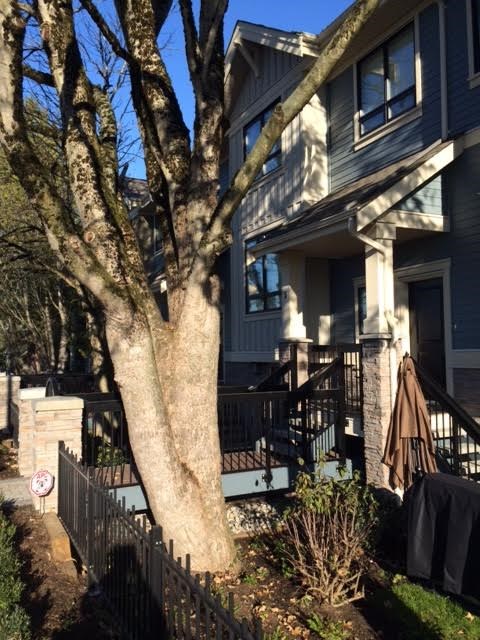
Saving what is left
Part of Jaggs’ job also entails keeping trees healthy. His team has some innovative tricks up its sleeve.
Notably, Jaggs said there are “unique problems” in maintaining trees in Richmond. The biggest, perhaps, is the flood plain; when a new home is built it is raised to a new elevation. This can suffocate roots, so a large tree needs to have its drip line (the part below the canopy) protected.
As well, development means digging, and Jaggs is constantly on the phone with builders instructing them to properly manage tree roots by installing root barriers to protect structures, for example.
Jaggs encourages builders to hydro-excavate (digging a hole with high pressure water) to install utility lines, instead of cutting the roots. Also, if a fence is to be installed, a builder can create a bridge across the root system instead of laying down concrete, noted Jaggs.
Another big tool for the team, said Jaggs, is education, such as notifying people of the perils of tree topping — when the main trunk is cut at the top, leading to rot over time.
Jaggs said many of the unhealthy trees that are cut down are a result of topping.
“We will definitely have a more healthy tree canopy in 20-25 years. Topping wasn’t considered to be bad 20 years ago,” noted Jaggs.
But while some cities have recently performed satellite-assisted tree canopy studies — with Vancouver finding its canopy had been reduced from 22 per cent in 1996 to 18 per cent in 2014 — Richmond has not done so, however Jaggs said the city is planning to.
MacGougan said she is concerned about the existing tree canopy.
“What’s happening is they’re replacing a mature tree with a small tree that then takes decades to grow. I won’t live long enough to see those trees grow to maturity,” she said.
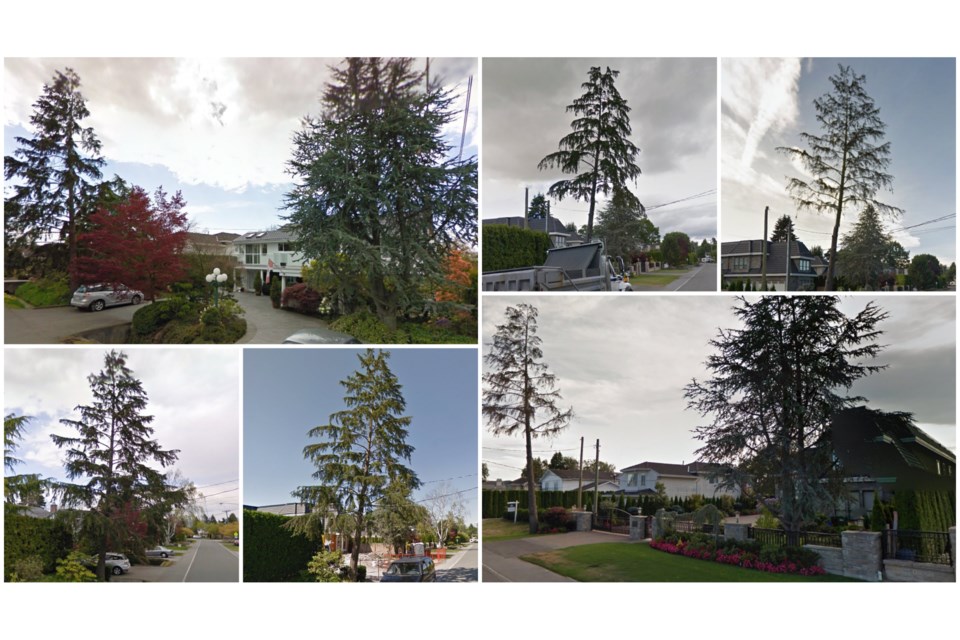
Intensive care?
Most recent arborist reports for rezoning applications assessed by the Richmond News found unhealthy or dangerous trees. Jaggs said there are many reasons for this (an epidemic not being one of them).
According to reports Trees may be cut down because they look “sparse” or even if they have co-dominant stems (deemed hazardous).
Jaggs said it is by way of the development application that his team and the city’s contracted arborists are able to assess a tree’s health.
“Rezoning provides an opportunity for more scrutiny,” said Jaggs.
Lee is skeptical.
“I’m concerned that the city and the arborists have their own agenda. I’m wondering how these trees that are fairly young can be considered so unhealthy?”
Resident Dean Beauvais is also skeptical of arborist reports.
Beauvais noted a perception among many residents is that trees are declared unhealthy when it is convenient.
“The ‘diseased’ response is the only answer you will get from anyone (at the city),” he said.
Retired forestry manager Rod Beaumont, a longtime Richmondite, noted the vast majority of Richmond’s mature/significant trees are relatively young (40-60 years), having been planted on what once used to be farmland.
“My personal view is you can find every tree to be unhealthy or you can find every tree to be healthy. It depends on what you want to do with it,” said Beaumont.
However, Beaumont noted Richmond soils do in fact pose unique problems. Furthermore, certain urban trees may not live as long as they would in a forest.
Beaumont is, however, concerned about tree protection, claiming at least half of the trees being saved are inadequately protected.
Beaumont notes suffocated root systems can stress, and eventually kill, trees.
“Underground, there’s a huge network of roots, they’re all intertwined. So it’s important to allow the tree to absorb nutrients,” said Beaumont.
Roots can be suffocated from a new home’s footprint or poor landscaping.
Comparing Google Street View images over the past eight years reveals many saved trees on redeveloped lots are showing visible signs of stress.
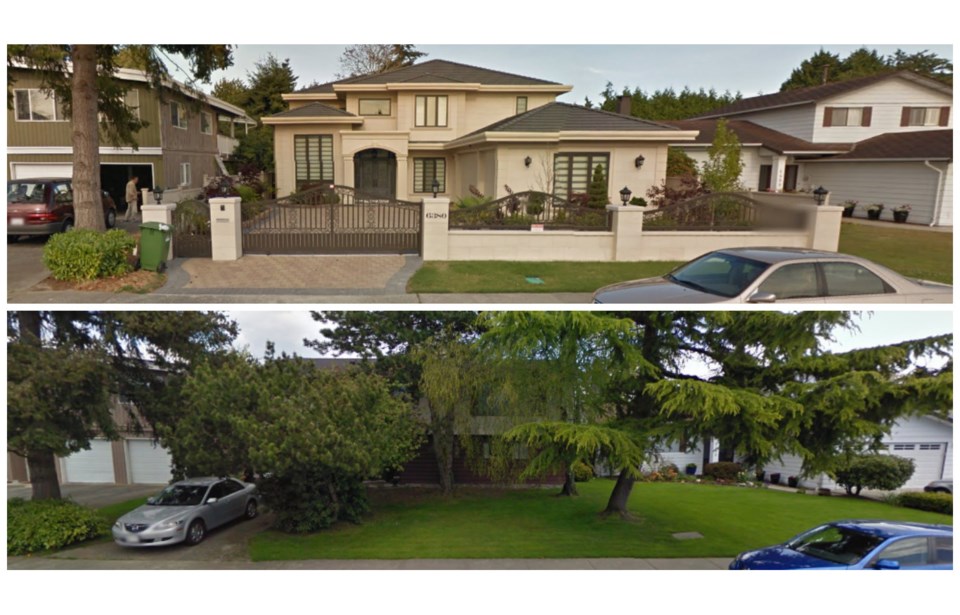
Fines a drop in the bucket?
Jaggs’ team is also tasked to ensure protective fencing is installed around protected trees during building. The increasingly iconic orange fences in Richmond neighbourhoods are supposed to be as wide as the tree’s canopy (drip line) and nothing is to be placed inside the fencing.
Richmond was one of the first municipalities in the region to initiate fines, noted Jaggs.
The city can fine a developer $1,000 for non-compliance of protective fencing.
Cutting down a tree without a permit can cost up to $10,000.
In the last three years the city has taken action against 103 construction sites, totaling $223,000 in fines.
MacGougan said the fines (established in 2006) aren’t stiff enough considering what new homes are being sold for these days.
“Trees are not properly valued. If developers had to pay the full cost of what that tree is worth environmentally and economically then they would then make some modifications in their development plans to save trees,” she said.
The Richmond News asked each member of Richmond city council for his or her thoughts on whether the tree bylaw was effective.
Only Coun. Carol Day responded, expressing concern that the bylaw “does not seem to affect new houses.”
“Our bylaws allow far too many trees to be destroyed and yet if a homeowner wants to remove a tree they often get a simple ‘no,’” from the city, said Day.
What you need to know:
To Inquire about tree-cutting permits or possible violations, call 604-247-4684 or email [email protected]. the emergency hotline is 604-270-8721.
Builders must protect neighbouring trees when a new house is being built. Certified arborists can provide tree health reports for about $100.
Tree-topping facts:
• Trees quickly regrow shoots at cut, adding height and density
• Requires more pruning over time
• Trees look less appealing
• Causes decay, disease and bark splitting
• Learn more at TreesAreGood.com
— City of Richmond
